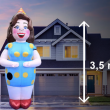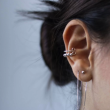When it comes to LED screens, one of the most important factors to consider is LED screen resolution. Resolution determines the clarity, detail, and overall quality of the images and videos displayed. Common terms you’ll often encounter include HD, FHD, QHD, and UHD. Each term refers to a different level of screen resolution, affecting how sharp and vibrant the visuals appear. Understanding these differences is key to choosing the right LED screen for your needs.
What Is LED Screen Resolution?
LED screen resolution refers to the number of pixels displayed on a screen. Pixels are tiny dots of light that combine to create an image. The more pixels there are, the higher the resolution and the clearer the image. Resolution is typically denoted by the number of horizontal pixels × the number of vertical pixels.
HD (High Definition) – 1280 × 720 pixels
HD is the baseline high definition standard and is sometimes called 720p. It offers 1280 pixels horizontally and 720 pixels vertically. HD resolution is suitable for smaller screens or applications where ultra-fine detail isn’t critical. It’s common in entry-level LED displays, small digital signage, and budget-friendly TVs.
FHD (Full High Definition) – 1920 × 1080 pixels
FHD or 1080p resolution is the next step up, featuring 1920 horizontal pixels and 1080 vertical pixels. This resolution has become the industry standard for TVs, monitors, and LED displays because it balances image clarity and performance efficiently. FHD is ideal for mid-sized LED screens used in offices, homes, or outdoor signage where a crisp, detailed image is needed.
QHD (Quad High Definition) – 2560 × 1440 pixels
QHD is often called 2K resolution and offers four times the pixel count of standard HD. With 2560 pixels horizontally and 1440 vertically, QHD delivers noticeably sharper images than FHD. This resolution is popular for high-end gaming monitors, professional displays, and advanced LED screens where enhanced detail and visual fidelity matter.
UHD (Ultra High Definition) – 3840 × 2160 pixels
UHD, commonly known as 4K resolution, offers the highest clarity with 3840 horizontal pixels and 2160 vertical pixels. UHD displays provide four times the pixels of FHD, resulting in breathtaking detail, vibrant colors, and an immersive viewing experience. UHD LED screens are ideal for large venues, cinemas, digital billboards, and premium home theater setups.
Choosing the Right Resolution for Your LED Screen
The best LED screen resolution depends on the intended use, viewing distance, and budget. For smaller screens or casual use, HD or FHD may be sufficient. If you want crisper images with fine detail, QHD and UHD resolutions are superior options, especially for larger screens or professional-grade displays.
In summary, knowing the differences between HD, FHD, QHD, and UHD empowers you to make informed decisions when selecting LED screens. As a leading optoelectronic semiconductor manufacturer, Kinglight offers a wide range of LED solutions with various resolutions to meet diverse customer needs, ensuring bright, clear, and stunning visuals every time.








